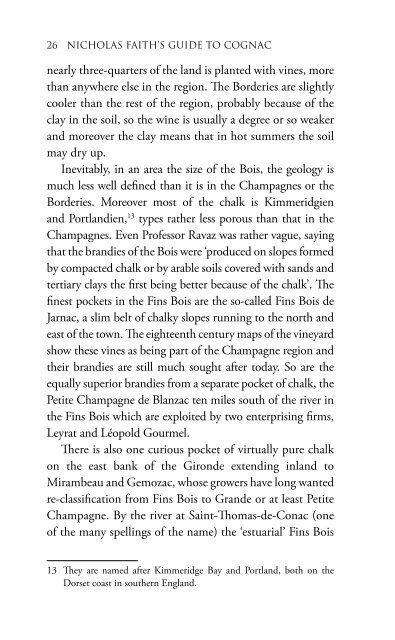Create successful ePaper yourself
Turn your PDF publications into a flip-book with our unique Google optimized e-Paper software.
nearly three-quarters of the land is planted with vines, more<br />
than anywhere else in the region. The Borderies are slightly<br />
cooler than the rest of the region, probably because of the<br />
clay in the soil, so the wine is usually a degree or so weaker<br />
and moreover the clay means that in hot summers the soil<br />
may dry up.<br />
Inevitably, in an area the size of the Bois, the geology is<br />
much less well defined than it is in the Champagnes or the<br />
Borderies. Moreover most of the chalk is Kimmeridgien<br />
and Portlandien, 13 types rather less porous than that in the<br />
Champagnes. Even Professor Ravaz was rather vague, saying<br />
that the brandies of the Bois were ‘produced on slopes formed<br />
by compacted chalk or by arable soils covered with sands and<br />
tertiary clays the first being better because of the chalk’. The<br />
finest pockets in the Fins Bois are the so-called Fins Bois de<br />
Jarnac, a slim belt of chalky slopes running to the north and<br />
east of the town. The eighteenth century maps of the vineyard<br />
show these vines as being part of the Champagne region and<br />
their brandies are still much sought after today. So are the<br />
equally superior brandies from a separate pocket of chalk, the<br />
Petite Champagne de Blanzac ten miles south of the river in<br />
the Fins Bois which are exploited by two enterprising firms,<br />
Leyrat and Léopold Gourmel.<br />
There is also one curious pocket of virtually pure chalk<br />
on the east bank of the Gironde extending inland to<br />
Mirambeau and Gemozac, whose growers have long wanted<br />
re-classification from Fins Bois to Grande or at least Petite<br />
Champagne. By the river at Saint-Thomas-de-Conac (one<br />
of the many spellings of the name) the ‘estuarial’ Fins Bois<br />
13 They are named after Kimmeridge Bay and Portland, both on the<br />
Dorset coast in southern England.<br />
can produce excellent long-lived brandies – as witness the<br />
quality of those from the Château de Beaulon. These prove<br />
the unfairness of the canard that they are iodiney because of<br />
the proximity of salt water – the water in this stretch of the<br />
estuary is not salty but fresh!<br />
I have come to believe, however, that the distinction<br />
between different terroirs – and this applies to other wine<br />
regions – is due far more to the physical characteristics of<br />
the soil rather than its precise chemical composition. Hence<br />
the general suitability of chalk soils, not only in <strong>Cognac</strong> but<br />
also, for instance in Champagne and Jerez. Professor Ravaz<br />
himself turned his back on a purely geological explanation<br />
of cognac’s qualities. As he said: ‘The clayey, siliceous soils<br />
of the Borderies produce brandies of a higher quality<br />
than those of the dry groies or even some of the chalkier<br />
districts in the south-west of the Charente-Inférieure.<br />
For the geological make-up of the earth itself is not as<br />
important as Coquand makes out.’ 14 Ravaz emphasised<br />
the combination of the chemical and physical constituents<br />
of the soil, with the physical predominant: ‘the highest<br />
qualities are produced from chalky soil, where the chalk is<br />
soft and highly porous and where the sub-soil is composed<br />
of thick banks of similar chalk’ (the topsoil is invariably<br />
only a few centimetres thick). In these soils, said Ravaz,<br />
‘the subsoil hoards rainwater, thanks to its sponginess<br />
and its considerable depth, and releases it slowly to the<br />
surface soil and to the vegetation. It is thus to a certain<br />
extent a regulator of the soil’s moisture content, and so, in<br />
chalky soils, the vine is neither parched nor flooded.’ As<br />
a result the roots of the vine can gain access to moisture<br />
14 The former name for the Charente-Maritime.


